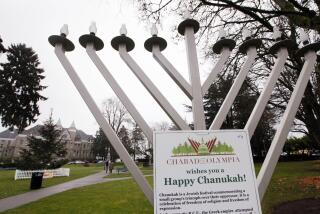Taking It From the Top
- Share via
Dreidel, dreidel, dreidel, I made it out of clay . . . So goes the refrain to a Hanukkah song well known to most Jewish children growing up in the United States--and to non-Jewish children who learn the song for school holiday programs. Unfortunately, for many, the next line of the song might as well be And I don’t know how to play. Even many adults who played with the four-sided spinning top every year as children don’t remember how to play the games based on the dreidel. In what may be something of a Jewish equivalent of the Peter Pan story, only children seem to know the rules. “That is true, that is true,” said Shahrokh Ghodsi, owner of the Golden Dreidle in Costa Mesa, which boasts one of the largest selections of dreidels in Southern California. “I don’t know why it’s the case, but it is true.
“That’s why we have these pamphlets,” Ghodsi said, handing over a small stack of one-sheet dreidel instructions. “Take a few,” he says. “Somebody you know needs them.”
Hanukkah, which lasts eight days and begins at sundown tonight, has packed the Golden Dreidle with shoppers this week. However much they may have played with dreidels in their youth, many admitted that they were now basically clueless when it came to the rules:
* Tracy Dorame of Costa Mesa: “I don’t remember. My mother doesn’t remember.”
* Dorie Cohen of Trabuco Canyon: “Every year we go through this. It’s a mental block. I always have to ask the kids, ‘How does it go?’ ”
* Linda Sheikewitz of Laguna Niguel: “The kids remember, but I don’t.”
Why can’t she remember?
“Why, because I’m busy doing latkes in the kitchen,” she said of her time spent preparing the potato pancakes traditionally served at Hanukkah.
Judy Wasserman of Mission Viejo remembered more than most: “Nun means none, right?”
Bingo.
The rules are simple enough. It takes two or more people to play. Each player begins with an equal number of markers, usually pennies or Hanukkah gelt (foil-wrapped chocolate coins), but also popcorn, buttons or anything else available in sufficient quantities.
The flyer that Ghodsi distributes in his shop calls for each player to put a marker in the center to start the game. Other sources specify five markers per player for the kitty; whenever the kitty is empty, each player adds one piece. The players spin the dreidel one at a time.
A different Hebrew character is on each of the dreidel’s four sides; when the dreidel stops spinning and falls, the letter on top tells the player what to do:
Nun, player takes nothing.
Gimel, player takes all.
Hay, player takes half.
Shin, player adds one piece to the kitty or loses the game.
At Gallery Judaica on Los Angeles’ Westside, which carries about 20 kinds of dreidels, an identical “cheat sheet” with those definitions is available to customers. “People pick up that piece of paper all of the time; it’s an absolutely wonderful little reminder,” the store’s Tina Oberman said. “On Fairfax Avenue, of course, the adults remember.” The area is home to many members of strict sects of Judaism.
*
Moises Paz, executive director of the Jewish Community Center of Orange County, said remembering the meaning of the Hebrew characters on the dreidel can be a snap.
“The letters give themselves away,” he said. “Nun is none, hay is half. Shin [begins] the Hebrew word shalem, which can mean ‘to pay.’ Gimel is like ‘get.’ ”
Players who have nothing left to give are out of the game. The game is over when one player has won all the markers.
The characters on each side of the top constitute an acronym formed from the first letters of a four-word Hebrew sentence meaning “A great miracle happened there.” Israeli dreidels are slightly different, because they derive from “A great miracle happened here.”
The great miracle was the reclaiming of the temple of Jerusalem and its rededication in 165 BC by a small band of Maccabees following the temple’s plunder by Syrian Greeks. That much is historical fact.
Tradition also holds that when Judas Maccabaeus searched for sacred oil to relight the temple menorah, a sacred candelabrum, he found only enough oil to last one day--yet it miraculously burned for eight.
Playing with dreidels is said to have begun before the Maccabees’ revolt, when the Syrian king Antioch IV forbade Jews to worship. Young boys met secretly to discuss phrases of scripture that they knew by memory. When Syrian soldiers happened upon them, the boys would take out a little wooden top so that the soldiers would think they were playing, not studying or praying.
Modern dreidel rules are borrowed from a central European gambling game of the Middle Ages.
Although rabbis don’t generally approve of gambling, they like the Hanukkah message to which the dreidel refers. According to “Hanukkah: Eight Nights, Eight Lights” by Malka Drucker (Holiday House, New York 1980), they also discovered another religious connection. Each Hebrew letter has a numerical equivalent, and the four letters on the dreidel add up to 358, the same numerical value as the letters in the Hebrew word for messiah.
In fact, one version of the dreidel game uses those numerical equivalents for scoring--nun 50, gimel 3, he 5 and shin 300--and the first player to reach 1,000 wins. Drucker’s book offers other variations as well. The game can be made more challenging, for instance, by drawing a circle two feet in diameter; if the spinning dreidel falls outside the circle, the player loses a turn.
For those who find all that too complex, the dreidel can also be played simply as a spinning game: Whoever spins it the longest is the winner. That’s what Beverly Berman, assistant to the rabbi at Stephen S. Wise Temple in Los Angeles, admits she used to do. “I never knew how to play even when I was a kid. I just used to spin them,” she said.
The dreidel, a familiar symbol of Hanukkah in the United States, draws on an Ashkenazi, or Eastern European, Jewish tradition. Many Jews throughout the world do not incorporate it into their observance of Hanukkah, which is considered a minor Jewish festival in many countries.
Although it is a clay dreidel that stars in the Jewish folk song--”Dreidel, dreidel, dreidel, I made it out of clay / And when it’s dry and ready, O dreidel I will play”--most dreidels today are made of wood. But they also come in materials ranging from plastic to porcelain and are subject to a variety of artistic interpretations.
The Golden Dreidle carries more than a hundred kinds of dreidels. Among them are Lucite dreidels, glow-in-the-dark dreidels, Disney sports dreidels, Limoges dreidels from France, crystal dreidels from Italy and stained-glass dreidels from Israel. Collectible dreidels are often fashioned from hand-painted olive wood or sterling silver. (Small wooden and plastic dreidels start at 25 cents; collectibles can range from $15 to hundreds of dollars.)
Lest one imagine that the dreidel is a relic, now comes cyber-dreidel, straight from the 21st century. It can be accessed from the dreidel Web page of the Jewish Communication Network: https://www.jcn18.com/spin-ns.htm
The network’s home page includes the song “Cat’s Dreidel”:
I have a lovely body, with legs so long and thin,
My paw can fling that dreidel, and hit you in the shin.
Oh dreidel, dreidel, dreidel, my legs so long and thin,
Oh dreidel, dreidel, dreidel, I’ll scratch you on the chin.
Clicking on the Hanukkah icon lands you on the Hanukkah page and an invitation to “take a spin with the Internet’s first virtual dreidel.” An introduction to the “Great Computerized Dreidel Game” outlines the “great miracle” origins of the four dreidel letters.
Clicking the “Spin Me!” button sends the virtual dreidel spinning across the screen, eventually landing on its side and showing a letter. And a diagram shows how the four letters are used for wagering.
Just in case you didn’t know--or don’t remember.
More to Read
Sign up for The Wild
We’ll help you find the best places to hike, bike and run, as well as the perfect silent spots for meditation and yoga.
You may occasionally receive promotional content from the Los Angeles Times.






